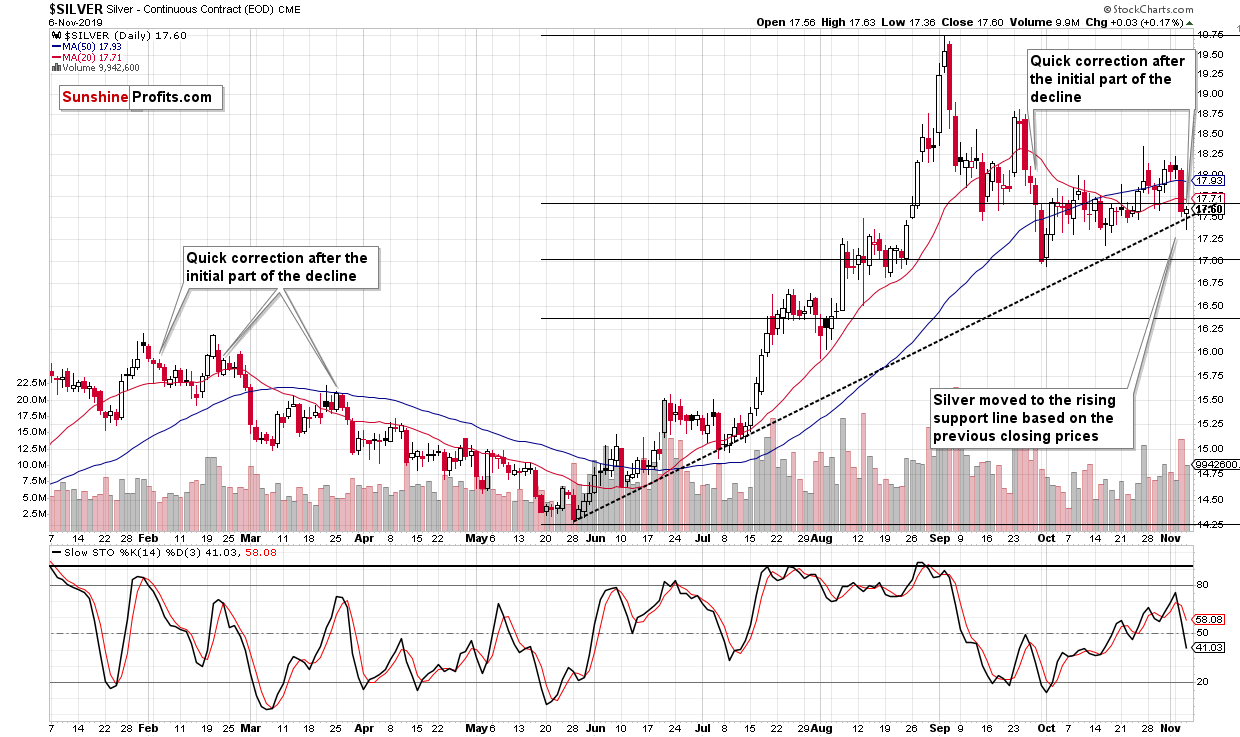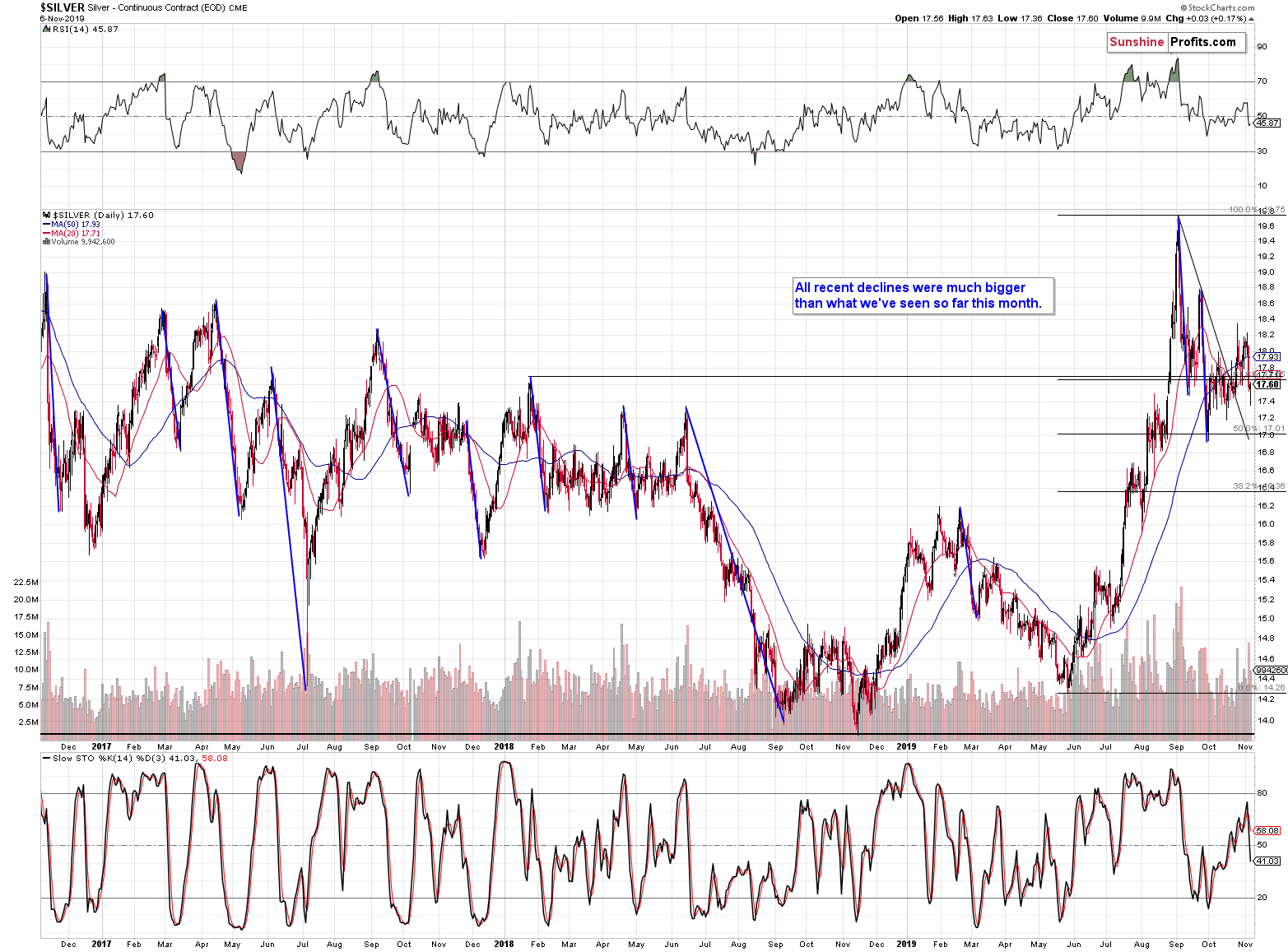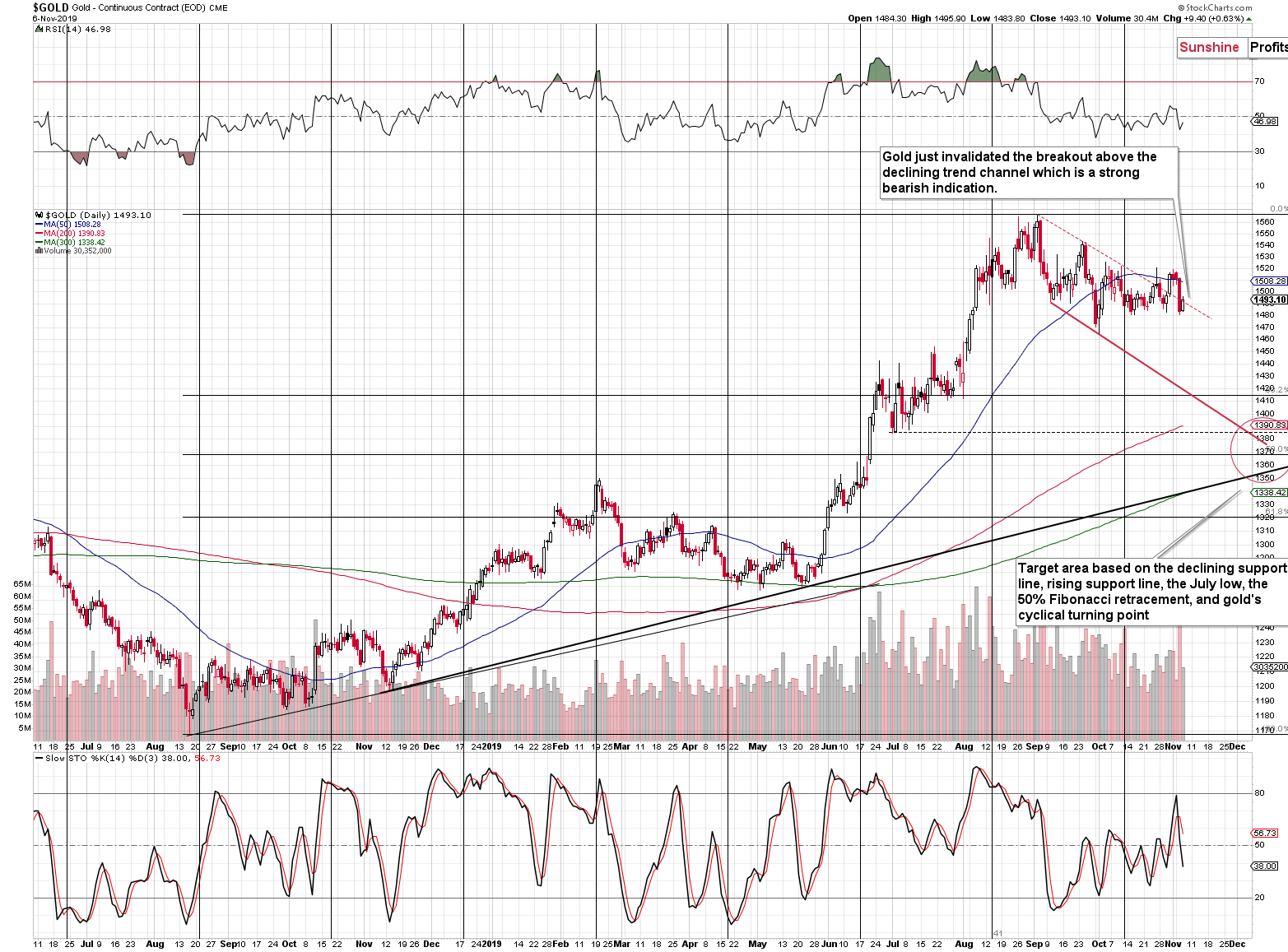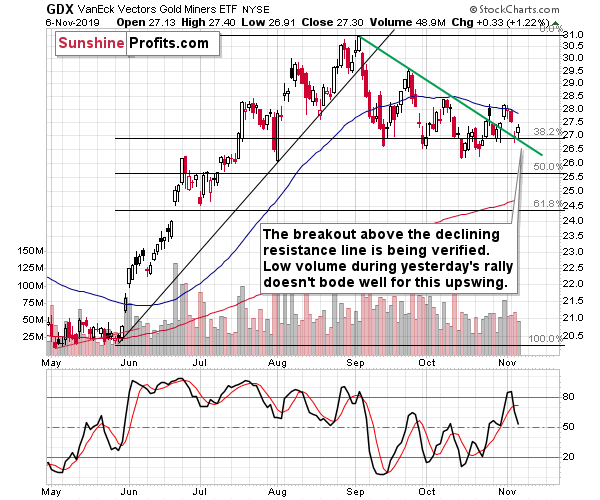Briefly: in our opinion, full (250% of the regular size of the position) speculative short position in gold, silver, and mining stocks is justified from the risk/reward point of view at the moment of publishing this Alert.
Silver plunged on Tuesday, just as it was likely to after the triple reversal that we've been writing about, and it was declining strongly during Wednesday's pre-market trading. And then it all changed. Silver soared before the U.S. markets opened and the white metal ended the session in the green. We definitely saw a silver reversal. But, was it significant and can it be trusted?
We doubt that and the below chart shows why.
About That Silver Reversal
We doubt the significance of yesterday's reversal in silver, because daily corrections after the big daily declines are not something that indicate a reversal. Conversely, it's something normal.
For instance, the intraday reversal that we saw in early February should have been - theoretically - followed by higher prices. It wasn't. It was simply a breather that silver took before continuing to decline. These daily pauses don't always take the same form. In late February, silver corrected by simply rallying a bit without an intraday reversal. And in late September, silver's pause took form of a significant slowdown in the pace at which silver was declining.
In all above-mentioned cases silver resumed its decline shortly. So, is this time really any different? That's unlikely.
Besides, silver had a good reason not to decline without looking back. The rising support line that's based on the previous lows in terms of closing prices (May and July lows) was just reached in intraday terms. Since the line is based on daily closing prices, and we didn't see a daily close below it yesterday, we don't view yesterday's price action as invalidation of the breakdown. The support held for now, but that's not enough to make the outlook bullish.
Moreover, let's keep in mind what we wrote in yesterday's Gold & Silver Trading Alert about the size of silver's decline so far:
Silver declined profoundly and it seems to be just starting its decline. Silver has recently outperformed on a very short-term basis after having formed a shooting star reversal. It doesn't seem that just a one-day decline or something only a little bigger than that is enough to really be a reasonable response to multiple strong sell signs. Similar signals in the past used to be followed by multi-dollar declines.
The move that we've seen so far, is too small even compared to the lesser silver declines. And if we compare it to silver's bigger declines, it's almost nonexistent.
Even if we consider yesterday's pre-market downswing to be a part of the decline, the entire move is still tiny compared to even the smaller of the previous declines. Taking this comparison into account it's even more likely that yesterday's reversal was not the end of the decline in silver but rather a pause within it.
All in all, predicting higher silver prices here based on yesterday's small reversal is not justified - at least not yet.
Gold and mining stocks agree with the above interpretation of yesterday's "reversal" in silver.
Gold and Gold Miners
The yellow precious metal moved a bit higher yesterday, but there are two important details about this move:
- Gold closed at the upper border of the declining trend channel - there was no breakout above it
- The volume on which gold moved higher was relatively weak.
The second point is an overall bearish indication, while the first point answers the "was gold's rally big enough to change the short-term outlook" question. It wasn't.
The market appears to agree with us today as at the moment of writing these words, gold is trading very close to its yesterday's pre-market lows.
Unlike gold, mining stocks are above their declining resistance line that just served as support, but yesterday's volume was also relatively low. The size of the move nothing to call home about.
The notable detail here is that the Stochastic Oscillator was above 80 before declining recently. This is the first time it's been so high before flashing a sell signal, which indicates that the most recent top was more significant than the size of the preceding rally suggests. The last time Stochastic flashed a sell signal after being above 80 was in early September. That was when GDX declined about $4 in less than 2 weeks. That's yet another reason to think that yesterday's price action in the precious metals sector was just a pause, not a true reversal.
Consequently, everything that we wrote in yesterday's extensive Alert about the likelihood of seeing decline's continuation and about the next downside target for gold, remains up-to-date.
Naturally, the other key bearish factors for the medium term remain intact as well.
Key Factors to Keep in Mind
Critical factors:
- The USD Index broke above the very long-term resistance line and verified the breakout above it. Its huge upswing is already underway.
- The USD's long-term upswing is an extremely important and bearish factor for gold. There were only two similar cases in the past few decades, when USD Index was starting profound, long-term bull markets, and they were both accompanied by huge declines in gold and the rest of the precious metals market
- Out of these two similar cases, only one is very similar - the case when gold topped in February 1996. The similarity extends beyond gold's about a yearly delay in reaction to the USD's rally. Also the shape of gold price moves prior to the 1996 high and what we saw in the last couple of years is very similar, which confirm the analysis of the gold-USD link and the above-mentioned implications of USD Index's long-term breakout.
- The similarity between now and 1996 extends to silver and mining stocks - in other words, it goes beyond USD, gold-USD link, and gold itself. The white metal and its miners appear to be in a similar position as well, and the implications are particularly bearish for the miners. After their 1996 top, they erased more than 2/3rds of their prices.
- Many investors got excited by the gold-is-soaring theme in the last few months, but looking beyond the short-term moves, reveals that most of the precious metals sector didn't show substantial strength that would be really visible from the long-term perspective. Gold doesn't appear to be starting a new bull market here, but rather to be an exception from the rule.
- Gold stocks appear to be repeating their performance from 20 years ago, which means that a bottom in the entire precious metals sector is quite likely to form at much lower prices, in about a year
Very important, but not as critical factors:
- Long-term technical signs for silver, i.a. the analogy in terms of price to what we saw in 2008, shows that silver could slide even below $10.
- Silver's very long-term cycles point to a major reversal taking place right now and since the most recent move was up, the implications are bearish (this is also silver's technical sign, but it's so important that it deserves its own point)
- Long-term technical signs for gold stocks point to this not being a new gold bull market beginning. Among others, it's their long-term underperformance relative to gold that hint this is rather a corrective upswing within a bear market that is not over yet.
- Record-breaking weekly volume in gold is a strong sign pointing to lower gold prices
Important factors:
- Extreme volume reading in the SIL ETF (proxy for silver stocks) is an effective indication that lower values of silver miners are to be expected
- Silver's short-term outperformance of gold, and gold stocks' short-term underperformance of gold both confirm that the precious metals sector is topping here
- Gold topped almost right at its cyclical turning point, which makes the trend reversal more likely
- Copper broke below its head-and-shoulders pattern and confirmed the breakdown. The last time we saw something similar was in April 2013, when the entire precious metals sector was on the verge of plunging lower.
Moreover, please note that while there may be a recession threat, it doesn't mean that gold has to rally immediately. Both: recession and gold's multi-year rally could be many months away - comparing what happened to bond yields in the 90s confirms that.
Summary
Summing up, the outlook for the precious metals sector remains very bearish for the following weeks and months and given the current triple reversal, it seems likely that the counter-trend rally is already over.
The profits from the short position in gold, silver and mining stocks are likely to be legendary, but the difficult part is not to miss the decline, which is why we're rather reluctant to exit the short position very often. Still, since no market moves up and down in a straight line, it makes sense to time the moves that appear to have favorable risk to reward ratios. Based on the information that we have available right now, it seems that the next opportunity to take profits from the short positions and perhaps enter long positions will take place next month, quite likely close to $1,400 in gold.
As always, we'll keep you - our subscribers - informed.
To summarize:
Trading capital (supplementary part of the portfolio; our opinion): Full speculative short position (250% of the full position) in gold, silver, and mining stocks are justified from the risk/reward perspective with the following stop-loss orders and binding exit profit-take price levels:
- Gold: profit-take exit price: $1,391; stop-loss: $1,573; initial target price for the DGLD ETN: $36.37; stop-loss for the DGLD ETN: $25.44
- Silver: profit-take exit price: $15.11; stop-loss: $19.06; initial target price for the DSLV ETN: $24.88; stop-loss for the DSLV ETN: $14.07
- Mining stocks (price levels for the GDX ETF): profit-take exit price: $23.21; stop-loss: $30.11; initial target price for the DUST ETF: $14.69; stop-loss for the DUST ETF $6.08
In case one wants to bet on junior mining stocks' prices, here are the stop-loss details and target prices:
- GDXJ ETF: profit-take exit price: $30.32; stop-loss: $41.22
- JDST ETF: profit-take exit price: $35.88 stop-loss: $12.46
Long-term capital (core part of the portfolio; our opinion): No positions (in other words: cash)
Insurance capital (core part of the portfolio; our opinion): Full position
Whether you already subscribed or not, we encourage you to find out how to make the most of our alerts and read our replies to the most common alert-and-gold-trading-related-questions.
Please note that the in the trading section we describe the situation for the day that the alert is posted. In other words, it we are writing about a speculative position, it means that it is up-to-date on the day it was posted. We are also featuring the initial target prices, so that you can decide whether keeping a position on a given day is something that is in tune with your approach (some moves are too small for medium-term traders and some might appear too big for day-traders).
Plus, you might want to read why our stop-loss orders are usually relatively far from the current price.
Please note that a full position doesn't mean using all of the capital for a given trade. You will find details on our thoughts on gold portfolio structuring in the Key Insights section on our website.
As a reminder - "initial target price" means exactly that - an "initial" one, it's not a price level at which we suggest closing positions. If this becomes the case (like it did in the previous trade) we will refer to these levels as levels of exit orders (exactly as we've done previously). Stop-loss levels, however, are naturally not "initial", but something that, in our opinion, might be entered as an order.
Since it is impossible to synchronize target prices and stop-loss levels for all the ETFs and ETNs with the main markets that we provide these levels for (gold, silver and mining stocks - the GDX ETF), the stop-loss levels and target prices for other ETNs and ETF (among other: UGLD, DGLD, USLV, DSLV, NUGT, DUST, JNUG, JDST) are provided as supplementary, and not as "final". This means that if a stop-loss or a target level is reached for any of the "additional instruments" (DGLD for instance), but not for the "main instrument" (gold in this case), we will view positions in both gold and DGLD as still open and the stop-loss for DGLD would have to be moved lower. On the other hand, if gold moves to a stop-loss level but DGLD doesn't, then we will view both positions (in gold and DGLD) as closed. In other words, since it's not possible to be 100% certain that each related instrument moves to a given level when the underlying instrument does, we can't provide levels that would be binding. The levels that we do provide are our best estimate of the levels that will correspond to the levels in the underlying assets, but it will be the underlying assets that one will need to focus on regarding the signs pointing to closing a given position or keeping it open. We might adjust the levels in the "additional instruments" without adjusting the levels in the "main instruments", which will simply mean that we have improved our estimation of these levels, not that we changed our outlook on the markets. We are already working on a tool that would update these levels on a daily basis for the most popular ETFs, ETNs and individual mining stocks.
Our preferred ways to invest in and to trade gold along with the reasoning can be found in the how to buy gold section. Additionally, our preferred ETFs and ETNs can be found in our Gold & Silver ETF Ranking.
As a reminder, Gold & Silver Trading Alerts are posted before or on each trading day (we usually post them before the opening bell, but we don't promise doing that each day). If there's anything urgent, we will send you an additional small alert before posting the main one.
Thank you.
Sincerely,
Przemyslaw Radomski, CFA
Editor-in-chief, Gold & Silver Fund Manager







